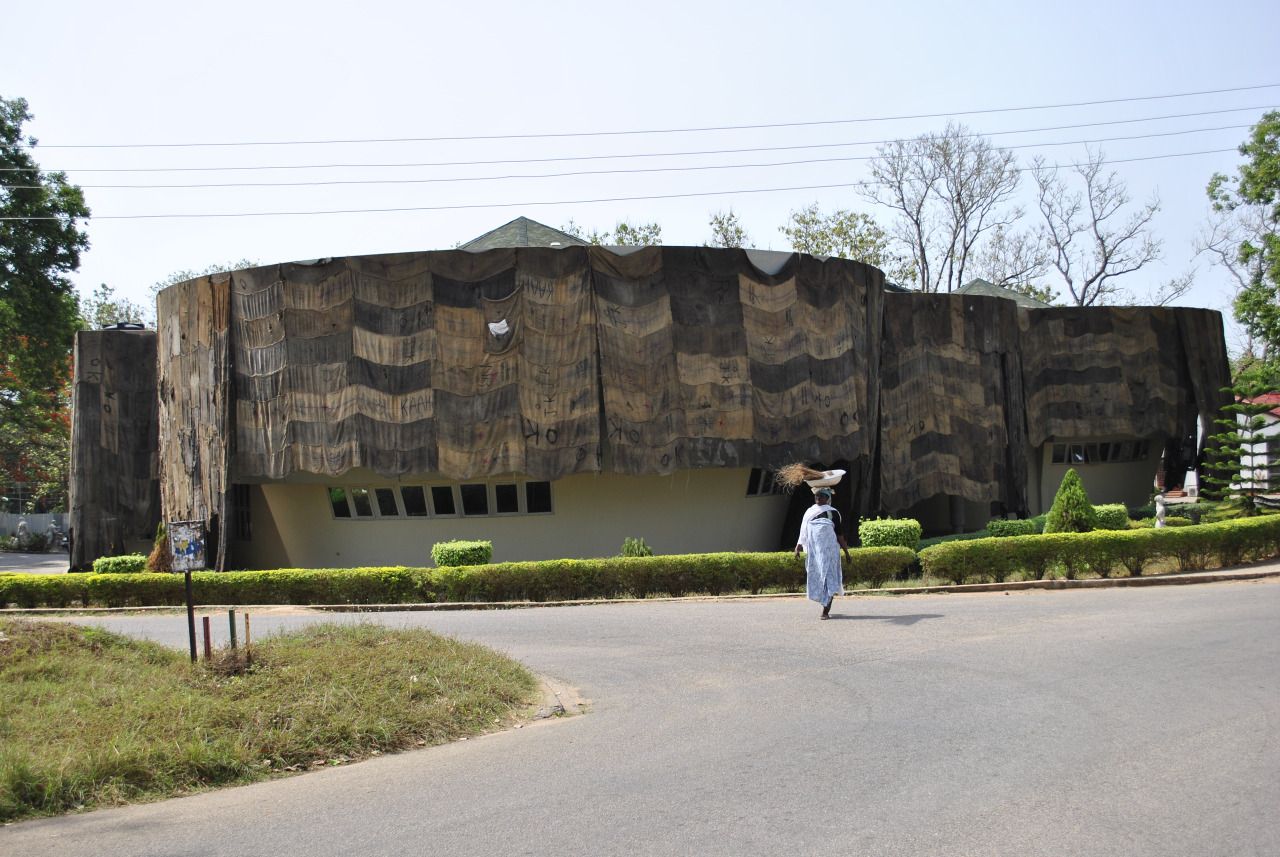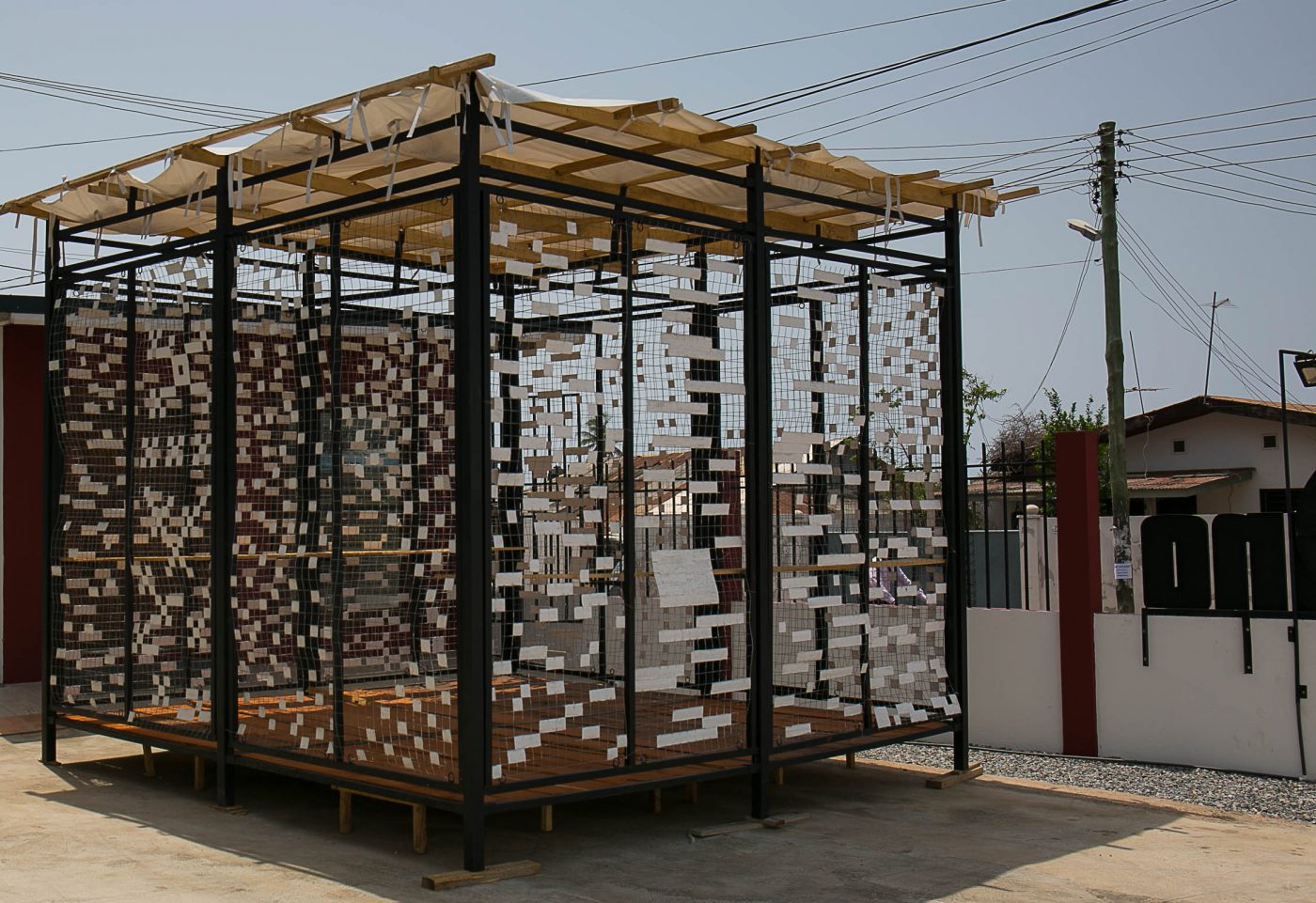
Installation shot of Ibrahim Mahama’s show at ANO in 2012
Mapping cultural Africa – Nana Oforiatta Ayim on the African Cultural Encyclopaedia
Nana Oforiatta Ayim has given herself a gigantic task: mapping the cultural landscape of the African continent. Ghana is the first nation (with another 53 to go!) whose arts and culture, contemporary and historical, are being mapped and archived with the aid of a mobile museum the size of a kiosk.
In August 2016 a project took place that can be taken as the launch of Oforiatta Ayim’s idea to compile an encyclopedia of African culture. At the Chale Wote Festival, an annual arts festival in the historic Jamestown district in Accra, ANO launched the Kiosk Museum, a museum the size of an average street kiosk, that showcased a small survey of festivals in Ghana by photographer Ofoe Amegavie. The show’s street appearance in the size of a modest kiosk can also be seen as a critique of institutional culture: “The Museum in the Ghanaian context, is a problematic interpreter of cultural heritage and knowledge”, according to the description on ANO’s website. It is inaccessible, because “public displays seem irrelevant and unrepresentative of the cultural wealth inherent in the country.” In other words, the traditional museum focuses on certain cultures that seems more at the service of the institution than the nation’s people in whose name it exists. This dividing mechanism of the museum is inherent in its roots in the colonial era, when the museum served as an important actor to produce a distinction between a dominant and a subordinate culture – the one presented as a modern target, the other as a relic from past traditions. Oforiatta Ayim’s project goes against the grain of such a hierarchy handed down from colonial epistemological and institutional structures.

Latifah Iddriss - Kiosk. Photo by Desire Clarke
This might be an obvious question, but what’s the purpose of this encyclopedia? What does it have to offer that is not already to be found on the internet?
Much important information on African cultures is not on the internet and much of it has not been translated. The project not only focuses on visual art, it covers all kinds of cultural expressions, today and in the past. We want to cover 54 African nations in 54 volumes that eventually will make up the encyclopedia. I give you one example of how we are approaching this in Ghana. We divide the country in the ten different regions of which it consists, and we plan road trips through all of these regions with our mobile museum, a kiosk-like structure designed by Latifah Iddriss, a young aspiring architect from Accra. From this mobile museum we gather important cultural expressions from the past or still ongoing, through oral sources and by visual documentation, for example. This can cover anything, be it poetry, festivals, music, design, art. Such information will form the content of the encyclopedia. Eventually we aim at a printed volume for each African country but the project continues on the internet as an open source enterprise. We should not expect it to be a finished process.
With who do you collaborate on this project?
I’m obviously not doing this on my own. If you take a look at the encyclopedia’s nascent website you will find the many people, all experts in some cultural field, that are collaborating in the Ghanaian leg of the project alone. The intention is that in each country someone like me will be responsible for putting editorial teams together that will cover vast territories, versatile disciplines and a myriad of cultural histories. They’ll be self-sustaining, yet following the blueprint that we are currently establishing with the example of Ghana. At this point I have good hopes that no less than ten countries will make a start soon and I’m confident to get all 54 on track. This is a project for the long term.
But is the format of an encyclopedia not also a residue of colonialism, of the dominant Enlightenment fiction, as it propagates the possibility of an all-encompassing knowledge, a panoptic controllability of the mind over nature and culture?
I’m not talking about an encyclopedia in that tradition. This one is opensource, a continuous project evolving over time. It does not pretend to have the last word or to be an ethnographically informed survey published in a lavish volume. This encyclopedia is definitely much broader yet at the same time it is willfully subjective in its selections. It is more an artwork than an encyclopedia but I use the term subversively. It is certainly not about creating some new cultural canon.
Talking about Western ethnographers, aren’t you yourself a relative outsider in Ghana? You are born and raised in Germany and have lived and studied in London.
No, it doesn’t feel like that, my mother lived in Ghana since I was young and I have a large family here of which I have always been a part. Having permanently settled in Accra five years ago felt like returning home. I do not see myself so much as a curator. I see myself as an art historian, a film maker and a writer, as someone with broad interests, as becomes apparent with the encyclopedia for instance. I am also working on a novel that will appear with Bloomsbury Publishers next year [2018].
“The encyclopedia is more an artwork than an encyclopedia but I use the term subversively. It is certainly not about creating some new cultural canon”

Felicia Abban (Ghana's first female portrait photographer). Photo by Desire Clarke
Does ANO have commercial ties? You have previously worked for Gallery 1957 in the Kempinski Hotel.
Yes, I was the gallery’s first creative director. But if you ask me, that space turned out to have speculative and commercial interests far beyond my scope of working in the arts. It now creates an atmosphere haunted by a neoliberal mantra unknown in the Ghanaian art scene and that I deem unhealthy. Some artists with whom I work or have been working are attracted by that buzz of commercialism, but more serious artists turn their backs towards it, like Ibrahim Mahama. ANO was always operating even during my year at the gallery, and after I left I reopened ANO as a platform for interesting projects like I have always been doing. Most of them are not about making profit. So I keep working with artists such as Mahama, but also with Nii Obodai and Felicia Abban and others in a project with which we aim to retrieve the photographic history of Ghana. As a matter of fact there are so many treasures here to be uncovered for larger audiences, and I would like to continue collaborating with existing structures such as the Nubuke Foundation, the Foundation for Contemporary Art, and the Art College of the Kwame Nkrumah University, than dig myself into short-lived art speculation. Alternative models of cooperation and cultural expression as we are creating at the moment are what is really interesting.
Cultural Encyclopaedia: http://www.culturalencyclopaedia.org/
ANO: http://anoghana.org/
Jelle Bouwhuis
PhD researcher Modern and Contemporary Art Museums, Globalization and Diversity, VU Amsterdam


